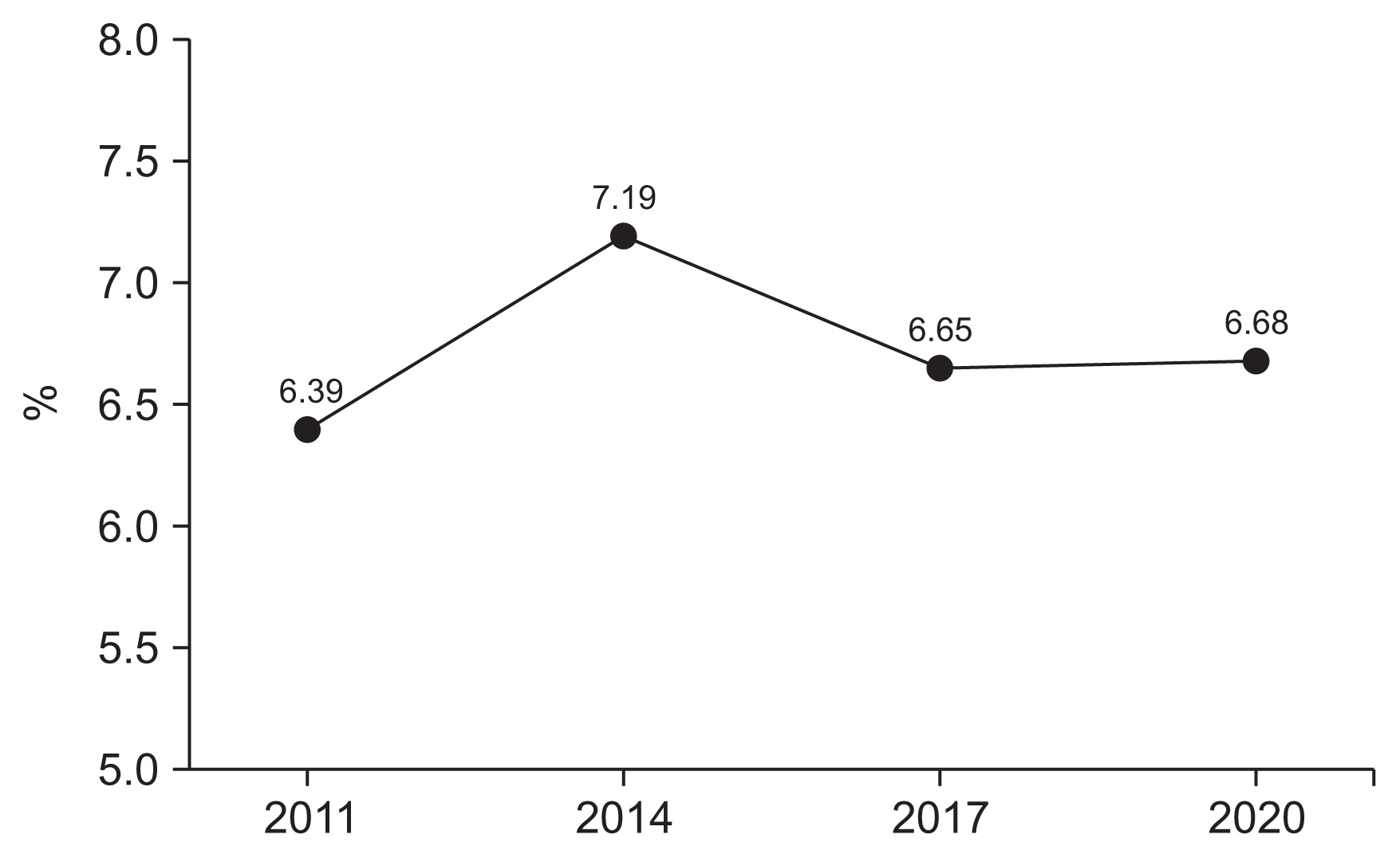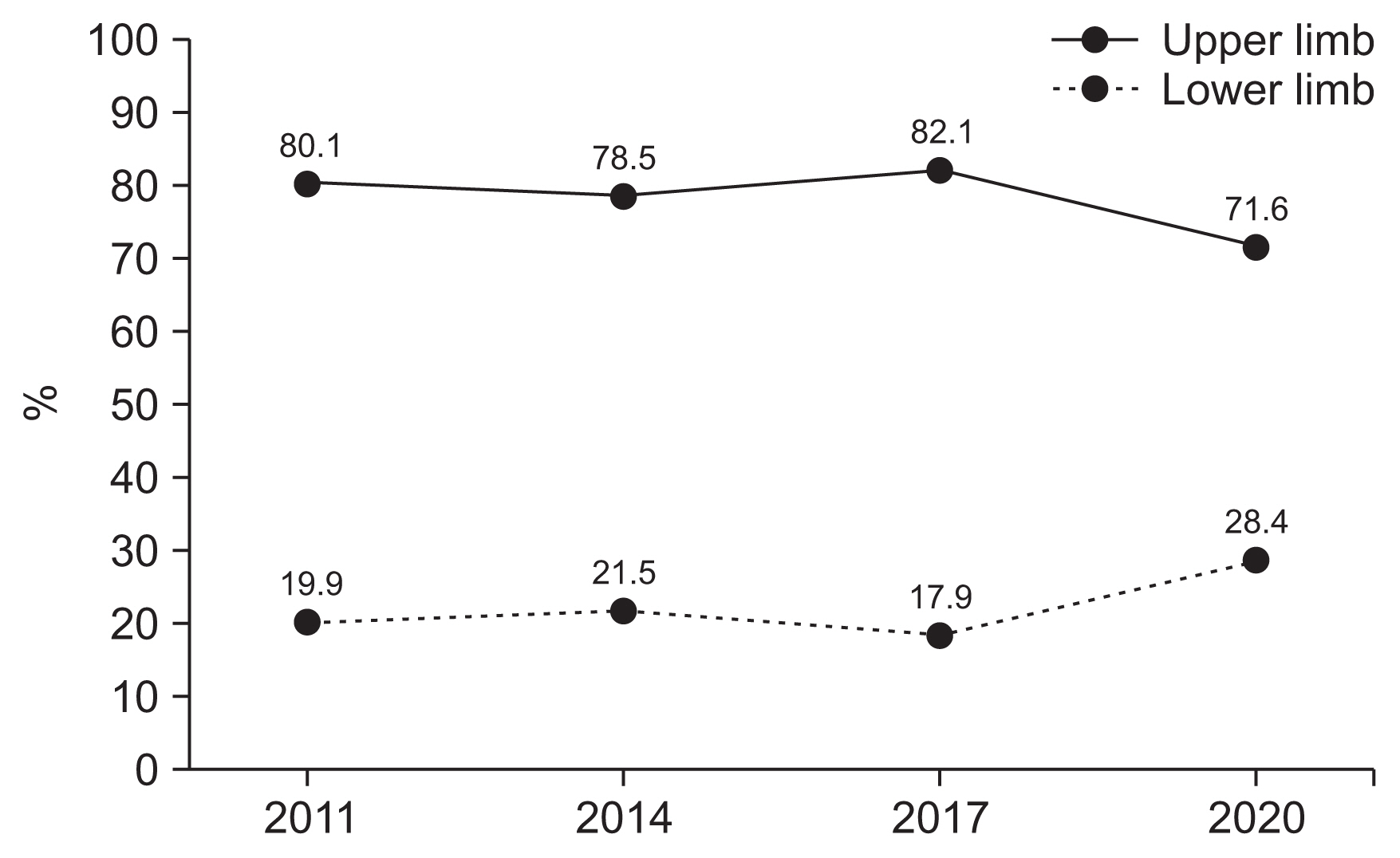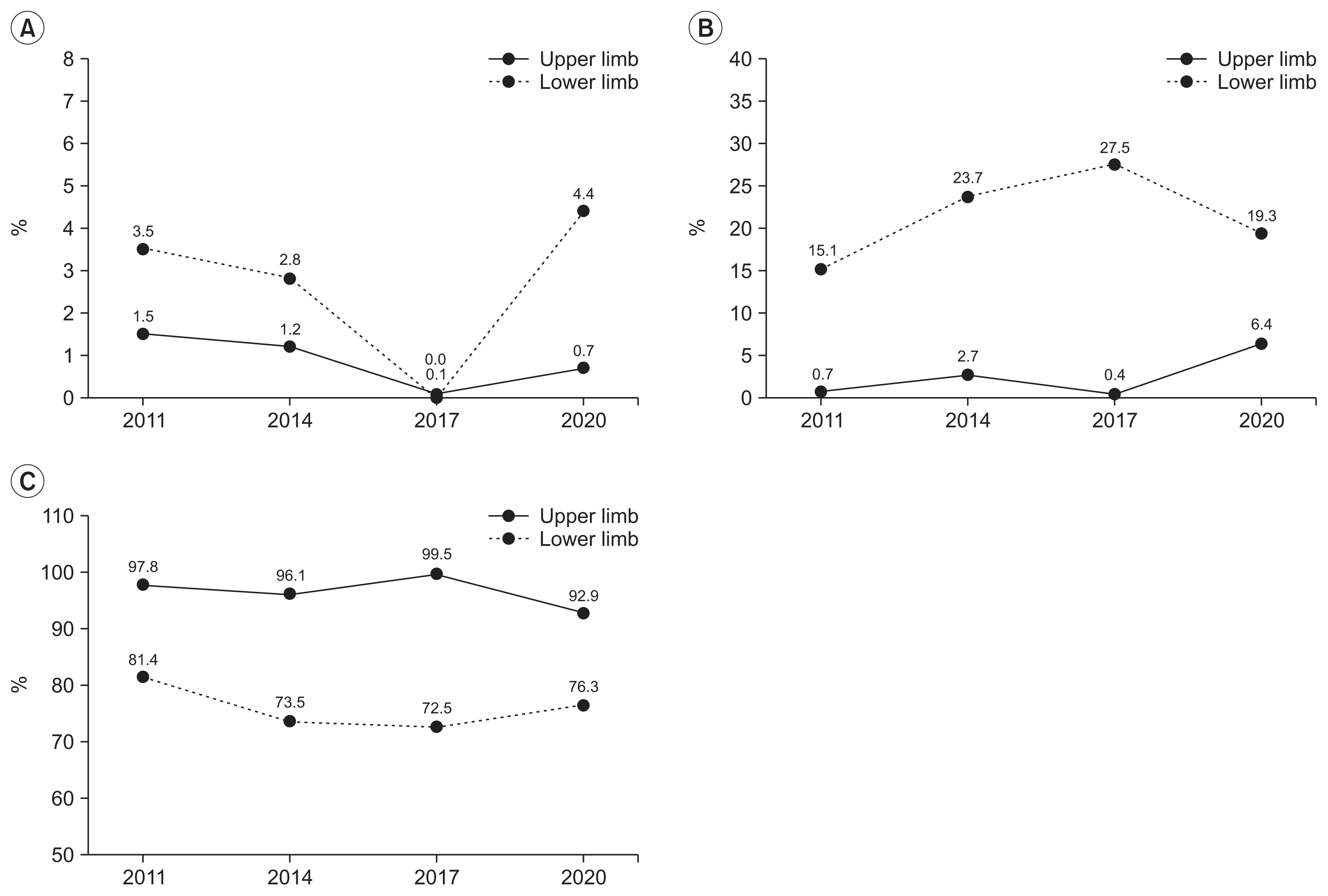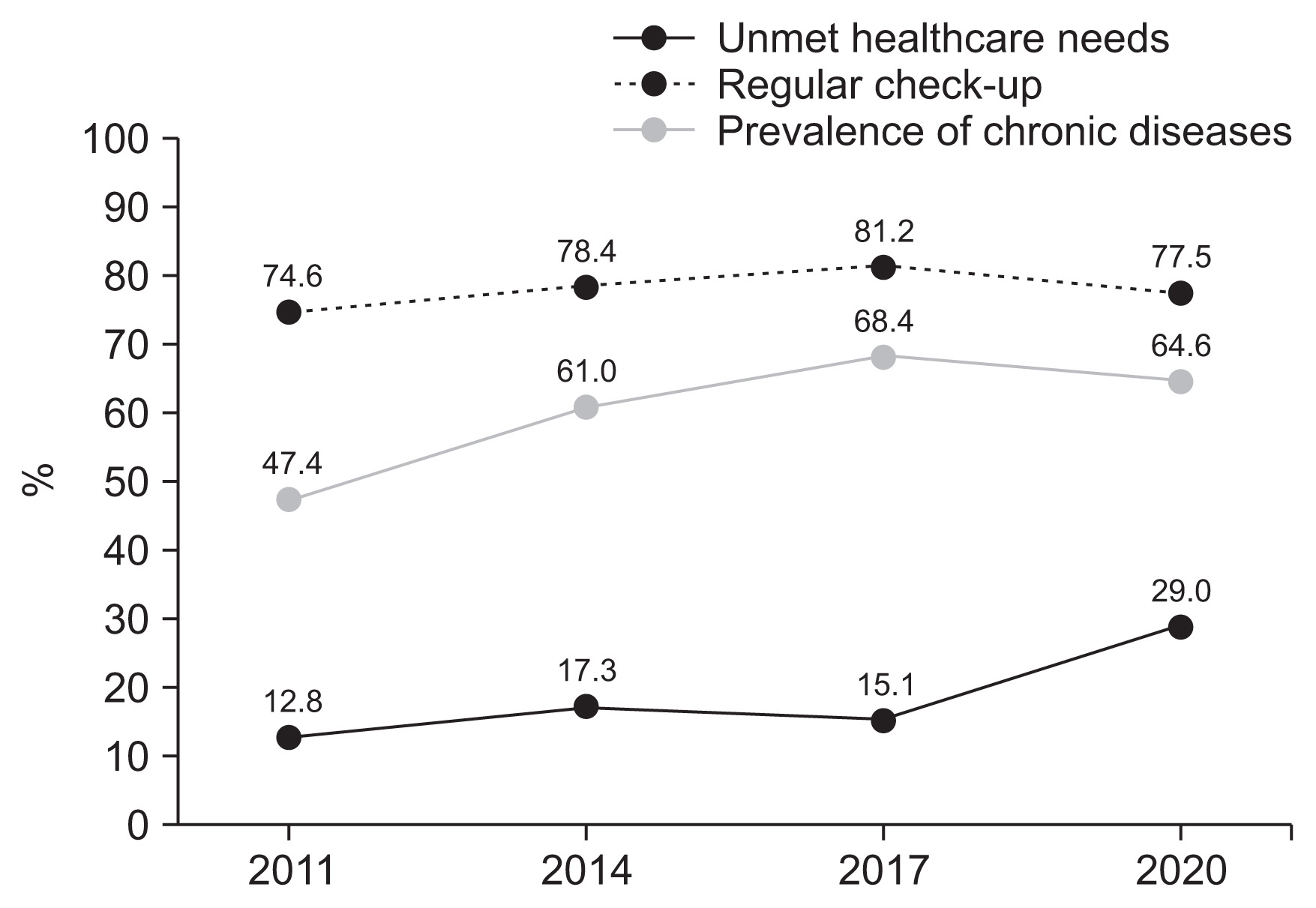Ann Rehabil Med.
2022 Oct;46(5):221-227. 10.5535/arm.22121.
Fact Sheet of Amputee 10-Year Trends in Korea: From 2011 to 2020
- Affiliations
-
- 1Department of Rehabilitation Medicine, College of Medicine, Chungnam National University, Daejeon, Korea
- 2Department of Nursing, College of Nursing, Chungnam National University, Daejeon, Korea
- KMID: 2535739
- DOI: http://doi.org/10.5535/arm.22121
Abstract
- This fact sheet was used to analyze the trends in the number of amputees within the population and changes in their health-related behaviors since 2011. Data from the National Survey of Disabled Persons in Korea from 2011 to 2020 were used in this study. The cases of amputation among people with disabilities have increased. Although there were more upper extremity amputations than lower extremity amputations, as amputations below the wrist account for a greater proportion in South Korea than in other countries, the number of upper extremity amputations decreased and lower extremity amputations increased. The most common cause of amputation is accidents, followed by diseases and congenital anomalies. The majority of the amputees were male; however, the number of females showed a gradual increase, and the average age also increased. The proportion of amputated patients with chronic diseases, such as diabetes and hypertension, is increasing, and medical services are relatively limited. In this review study, through the 10-year trend change in the prevalence of amputee, it was possible to infer the impact of personal, social, and environmental changes. Based on these amputee statistics, it is expected that they can be used to plan health and medical policies for the disabled.
Keyword
Figure
Reference
-
1. Namgoong S, Jung S, Han SK, Jeong SH, Dhong ES, Kim WK. Risk factors for major amputation in hospitalised diabetic foot patients. Int Wound J. 2016; 13:Suppl 1(Suppl 1). 13–9.
Article2. Mckechnie PS, John A. Anxiety and depression following traumatic limb amputation: a systematic review. Injury. 2014; 45:1859–66.
Article3. Dillon MP, Fortington LV, Akram M, Erbas B, Kohler F. Geographic variation of the incidence rate of lower limb amputation in Australia from 2007–12. PLoS One. 2017; 12:e0170705.
Article4. Ziegler-Graham K, MacKenzie EJ, Ephraim PL, Travison TG, Brookmeyer R. Estimating the prevalence of limb loss in the United States: 2005 to 2050. Arch Phys Med Rehabil. 2008; 89:422–9.
Article5. Essien SK, Kopriva D, Linassi AG, Zucker-Levin A. Trends of limb amputation considering type, level, sex and age in Saskatchewan, Canada 2006–2019: an in-depth assessment. Arch Public Health. 2022; 80:10.
Article6. Jeon I, Leigh JH, Ro JS, Ro YS, Lee SH, Shin HI, et al. Trends in the incidence of work-related traumatic limb amputations in South Korea from 2004 to 2013. Prosthet Orthot Int. 2019; 43:409–17.
Article7. Kim YC, Park CI, Kim DY, Kim TS, Shin JC. Statistical analysis of amputations and trends in Korea. Prosthet Orthot Int. 1996; 20:88–95.
Article8. Kamitani F, Nishioka Y, Noda T, Myojin T, Kubo S, Higashino T, et al. Incidence of lower limb amputation in people with and without diabetes: a nationwide 5-year cohort study in Japan. BMJ Open. 2021; 11:e048436.
Article9. Youn HM, Choi DW, Jang SI, Park EC. Disparities in diabetes-related avoidable hospitalization among diabetes patients with disability using a nationwide cohort study. Sci Rep. 2022; 12:1794.
Article10. Lee DH, Kim SY, Park JE, Jeon HJ, Park JH, Kawachi I. Nationwide trends in prevalence of underweight, overweight, and obesity among people with disabilities in South Korea from 2008 to 2017. Int J Obes (Lond). 2022; 46:613–22.
Article11. Kolossvary E, Ferenci T, Kovats T. Potentials, challenges, and limitations of the analysis of administrative data on vascular limb amputations in health care. Vasa. 2020; 49:87–97.
Article12. Korea Institute for Health and Social Affairs. National survey on persons with disabilities. Sejong, Korea: Korea Institute for Health and Social Affairs;2017.13. Lo J, Chan L, Flynn S. A systematic review of the incidence, prevalence, costs, and activity and work limitations of amputation, osteoarthritis, rheumatoid arthritis, back pain, multiple sclerosis, spinal cord injury, stroke, and traumatic brain injury in the United States: a 2019 update. Arch Phys Med Rehabil. 2021; 102:115–31.
Article14. Ma VY, Chan L, Carruthers KJ. Incidence, prevalence, costs, and impact on disability of common conditions requiring rehabilitation in the United States: stroke, spinal cord injury, traumatic brain injury, multiple sclerosis, osteoarthritis, rheumatoid arthritis, limb loss, and back pain. Arch Phys Med Rehabil. 2014; 95:986–995.e1.
Article
- Full Text Links
- Actions
-
Cited
- CITED
-
- Close
- Share
- Similar articles
-
- Prevalence and Current Management of Cardiovascular Risk Factors in Korean Adults Based on Fact Sheets
- Obesity Fact Sheet in Korea, 2021: Trends in Obesity Prevalence and Obesity-Related Comorbidity Incidence Stratified by Age from 2009 to 2019
- Korea hypertension fact sheet 2022: analysis of nationwide population-based data with a special focus on hypertension in the elderly
- Obesity Fact Sheet in Korea, 2020: Prevalence of Obesity by Obesity Class from 2009 to 2018
- Dementia Epidemiology Fact Sheet 2022





